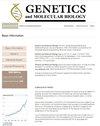倍性水平能否解释 Herbertia lahue(鸢尾科)的变异?
IF 1.3
4区 生物学
Q4 BIOCHEMISTRY & MOLECULAR BIOLOGY
引用次数: 0
摘要
多倍体通常与表型变异有关,正如在地生物种 Herbertia lahue 中观察到的那样。本研究考察了 H. lahue 的多倍体系列以及细胞遗传学、形态计量学和花粉数据。二倍体(2n=2x=14)呈现双峰核型,有两对长染色体和五对短染色体,而六倍体(2n=6x=42)和八倍体(2n=8x=56)的染色体大小逐渐减小。所有细胞型的卫星区都有与 18S rDNA 位点共定位的 CMA+/DAPI- 带(任何细胞型都没有 DAPI+ 带)。与二倍体和八倍体不同,六倍体的 5S rDNA 间隙位点与 18S rDNA 位点不处于同源位置。基因组大小可以间接预测细胞型,因为 2C 值会随着倍性水平的提高而增加。与二倍体相比,多倍体中 rDNA 位点数量的减少与其较低的 1Cx 值有关,这可能暗示了基因组的缩小过程。形态分析表明细胞型之间存在显著差异,判别分析确定了与细胞型相对应的三个形态分组。在花粉粒、鳞茎和子房特征方面观察到的表型变异表明了千粒重效应。总之,在所有分析的细胞型中,基因组和表型特征都出现了明显的分化,这表明 H. lahue 可能正在进行物种分化。本文章由计算机程序翻译,如有差异,请以英文原文为准。
Can ploidy levels explain the variation of Herbertia lahue (Iridaceae)?
Polyploidy is often related with phenotypic variation, as observed in Herbertia lahue, a geophyte species. This study examined the H. lahue polyploid series and departure in cytogenetic, morphometric, and pollen data. Diploids (2n=2x=14) present bimodal karyotype with two long and five short chromosome pairs, while hexaploids (2n=6x=42) and octoploids (2n=8x=56) present a gradual decrease in chromosome size. All cytotypes have CMA+/DAPI- bands co-localized with 18S rDNA sites in the satellite region (no DAPI+ bands in any cytotype). Unlike diploids and octoploids, 5S rDNA interstitial sites in hexaploids are not in a syntenic position with 18S rDNA sites. Genome size is effective as an indirect predictor of the cytotypes since 2C-values increased according to ploidy level. The reduction in the number of the rDNA sites in polyploids associated with their lower 1Cx-values compared to diploids may suggest a genome downsizing process. Morphometric analysis revealed significant differences among cytotypes, and discriminant analysis identified three morphometric groupings corresponding to the cytotypes. The phenotypic variation observed in pollen grains, bulbs, and ovary characters suggested the gigas effect. Concluding, remarkable differentiation was observed at both genomic and phenotypic characters in all the cytotypes analyzed, suggesting a possible ongoing speciation process in H. lahue.
求助全文
通过发布文献求助,成功后即可免费获取论文全文。
去求助
来源期刊

Genetics and Molecular Biology
生物-生化与分子生物学
CiteScore
4.20
自引率
4.80%
发文量
111
审稿时长
3 months
期刊介绍:
Genetics and Molecular Biology (formerly named Revista Brasileira de Genética/Brazilian Journal of Genetics - ISSN 0100-8455) is published by the Sociedade Brasileira de Genética (Brazilian Society of Genetics).
The Journal considers contributions that present the results of original research in genetics, evolution and related scientific disciplines. Manuscripts presenting methods and applications only, without an analysis of genetic data, will not be considered.
 求助内容:
求助内容: 应助结果提醒方式:
应助结果提醒方式:


